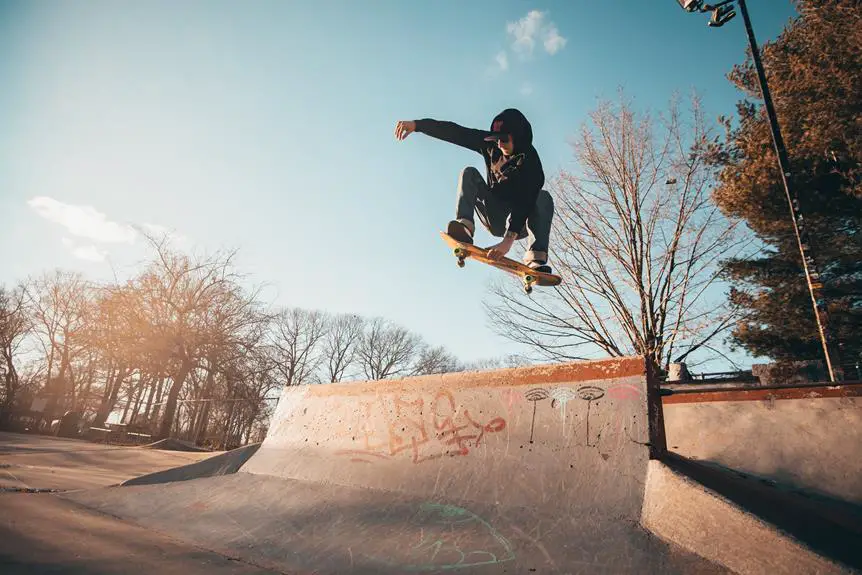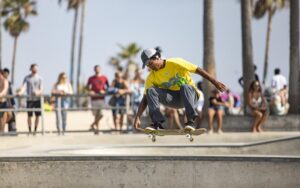Are you struggling to find your balance on a skateboard? Don’t worry. We’ve got you covered.
In this article, we’ll show you exactly how to achieve that perfect balance you’ve been craving. From understanding your center of gravity to building core strength, we’ll provide you with step-by-step guidance and exercises to help you master the art of balancing on a skateboard.
So, grab your board, put on your helmet, and get ready to become a confident and skilled skateboarder. Let’s get shredding!
Step-by-Step Guide to Achieving Skateboard Balance
Follow the following steps to achieve skateboard balance.
Find a flat and open practice area
Look for a skatepark with a smooth and spacious surface to practice your skateboard balance. A flat, open practice area is crucial for honing your skills and building confidence. Here are three reasons why finding the right practice area is essential:
- Safety: A flat surface reduces the risk of tripping or falling while you focus on improving your balance. It provides a stable foundation for practicing and developing skills without unnecessary obstacles.
- Freedom: A spacious practice area allows you to navigate freely without feeling restricted. It allows you to experiment with different techniques, tricks, and movements, enhancing your overall skateboarding experience.
- Community: Finding a skatepark with a flat and open practice area creates a sense of belonging. You’ll likely meet fellow skateboarders who share your passion and can offer guidance and support, creating a supportive and encouraging community.
Stand on your skateboard with your feet positioned just behind the bolts
Place your feet behind the bolts and find your balance on the skateboard. Proper foot position is crucial for maintaining skateboard balance and control. Positioning your feet just behind the bolts creates a stable foundation that allows for better maneuverability and responsiveness.
This positioning ensures that your center of gravity is balanced and aligned with the skateboard, allowing for better stability and control.
Bend your knees slightly to lower your center of gravity
Keep your knees slightly bent to lower your center of gravity and achieve better balance on your skateboard. This simple adjustment can make a world of difference in your skateboarding experience. Here’s why:
- Increased Stability: By bending your knees, you create a solid base that helps you maintain stability on the skateboard. It allows you to absorb any bumps or vibrations, keeping you steady and in control.
- Improved Control: Lowering your center of gravity gives you more control over your movements on the skateboard. You’ll be able to make sharper turns, execute tricks precisely, and easily navigate obstacles.
- Enhanced Confidence: You’ll feel more confident on your skateboard with better balance. This boost in confidence will empower you to try new tricks and push your limits, ultimately leading to a sense of belonging within the skateboarding community.
Gradually shift your weight side to side, getting a feel for balance
Start by swaying your body weight gradually from side to side on the skateboard, allowing yourself to develop a sense of balance. This is an important step in mastering the art of skateboarding.
As you shift your weight, you’ll begin to feel how your body and the skateboard work together to maintain balance. Start by placing your feet shoulder-width apart and parallel to each other on the skateboard. Bend your knees slightly and engage your core muscles to maintain stability.
Shift your weight to one side by leaning your upper body in that direction while keeping your lower body centered over the skateboard. Then, slowly shift your weight to the other side, maintaining control and balance.
This exercise will help you develop a natural rhythm and feel for how your body moves on the skateboard. Remember to keep your movements smooth and controlled, gradually increasing the range of your weight shifts as you gain confidence in your balance.
Practice leaning forward and backward while maintaining control
Try leaning forward and backward while maintaining control to enhance your skateboard balance further. This skill is important to master as it allows you to adapt to different terrain and maintain stability while performing tricks.
To help you improve your balance, here are some tips:
- Start by finding a flat, open space where you feel comfortable practicing.
- Stand on your skateboard with your feet shoulder-width apart and knees slightly bent.
- Slowly shift your weight forward, leaning over your front foot while maintaining balance and control.
- Gradually shift your weight backward, leaning over your back foot while maintaining control.
- Focus on keeping your core engaged and your upper body stable as you lean in different directions.
- Practice this movement repeatedly, gradually increasing the intensity and duration.
- Remember always to maintain control and avoid jerky movements that can throw off your balance.
- Don’t be afraid to challenge yourself and push your limits, but always prioritize safety.
By practicing leaning forward and backward while maintaining control, you’ll develop a strong sense of balance on your skateboard, allowing you to navigate any terrain and perform tricks with ease confidently.
Keep practicing and enjoy the feeling of belonging to the skateboarding community as you progress in your skills.
Experiment with turning and carving to improve balance
As you progress in your skateboard balance, continue to experiment with turning and carving to further enhance your skills. Turning and carving are essential techniques that improve your balance and allow you to easily navigate different terrains and perform tricks.
When turning, shift your weight toward the direction you want to go and use your body to guide the board. Carving involves making smooth, flowing turns by leaning into the turns and using your body to generate momentum.
This technique helps you maintain control and balance while adding style to your skateboarding.
Try gentle rides on uneven surfaces to enhance stability
To improve your stability on a skateboard, ride gently on uneven surfaces. This may sound counterintuitive, but it’s actually a great way to enhance your balance and control. Here are some tips to help you make the most out of these skateboard exercises on uneven surfaces:
- Embrace the challenge: Riding on uneven surfaces forces you to constantly adjust your balance, strengthening your core muscles and improving your overall stability.
- Start small: Begin by riding on slightly uneven pavement or a gravel path. As you become more comfortable, gradually increase the difficulty level by seeking out more rugged terrains.
- Stay relaxed: Tension in your body can throw off your balance. Focus on staying loose and flexible, allowing your body to naturally adjust to the terrain.
Gradually increase your speed as you gain confidence
Once you feel comfortable on your skateboard, gradually increase your speed to build confidence in your balancing abilities. It’s important to remember that balance is a skill that takes time and practice to develop, so don’t rush the process. By gradually increasing your speed, you allow yourself to adapt to the changes in momentum and maintain control over your board.
Exercises to Improve Skateboard Balance
To improve your skateboard balance, there are several exercises you can incorporate into your training routine.
Skater squat: Strengthening leg muscles and improving balance
To strengthen your leg muscles and improve your balance on a skateboard, try incorporating skater squats into your workout routine. Skater squats are a fantastic exercise that targets your legs and improves your stability on the skateboard.
Here are three reasons why skater squats are beneficial:
- Increased leg strength: Skater squats primarily target your quadriceps, hamstrings, and glutes. By performing this exercise regularly, you’ll develop stronger leg muscles, allowing you more control and power while skateboarding.
- Improved balance: Skater squats require you to balance on one leg while lowering your body down into a squat position. This exercise challenges your stability and helps you improve your balance, which is crucial for maintaining skateboard control.
- Correct skateboard foot position: Skater squats mimic your foot position when skateboarding. By practicing this exercise, you’ll become more comfortable with the proper foot placement, ensuring a solid foundation for your balance on the skateboard.
Incorporating skater squats into your workout routine will strengthen your leg muscles and enhance your balance, ultimately improving your performance on the skateboard.
Coordination exercises: Enhance overall balance and control
Improve your balance and control on a skateboard by incorporating coordination exercises into your training routine. These exercises will help you develop the necessary skills to maintain stability and control while skateboarding.
One important aspect of coordination is foot placement. Practice placing your feet in different positions on the skateboard to find your most comfortable and stable stance. Experiment with different widths and angles of your feet to see what works best.
Another key element is body position. Maintain a low center of gravity by bending your knees and keeping your weight centered over the skateboard. This will provide better balance and control.
To enhance your coordination, try performing exercises challenging your balance, such as standing on one leg or practicing yoga poses. These exercises will help improve your overall body awareness and stability on the skateboard.
Step-by-step guidance on performing these exercises
Once you have familiarized yourself with the earlier coordination exercises, it’s time to incorporate them into your regular skateboarding practice.
Follow these step-by-step instructions to improve your skateboard balance:
- Start by finding a flat and open area to practice in.
- Stand on your skateboard with your feet parallel to each other, shoulder-width apart.
- Bend your knees slightly and keep your weight centered over the skateboard.
- Practice shifting your weight from your toes to your heels and vice versa while maintaining your balance.
- Once you feel comfortable with weight shifting, try rolling slowly in a straight line.
- As you gain confidence, start turning by leaning your body in the direction you want to go.
- Remember to keep your core engaged and your gaze forward to maintain balance.
- Practice these exercises regularly to develop your skateboard balance and control.
By following these step-by-step instructions, you’ll gradually improve your skateboard balance and become more confident on your board.
Keep at it, and remember, practice makes perfect!
Common Mistakes and How to Avoid Them
You often make the mistake of leaning too far forward or backward when trying to balance on a skateboard, leading to falls and loss of control. Finding the right foot position for balance is important to avoid this common mistake.
Place your front foot perpendicular to the skateboard, with the ball of your foot positioned just behind the front bolts. Your back foot should be placed diagonally across the tail, with the toes hanging slightly off the edge.
This foot position allows for better control and stability while balancing on the skateboard. Remember to keep your weight centered and distributed evenly between both feet.
By maintaining this balanced foot position, you’ll be able to achieve better control and avoid unnecessary falls or loss of balance.
| Mistake | How to Avoid | Importance |
|---|---|---|
| Leaning too far forward or backward | Find the right foot position for balance | Maintains stability and control |
| Placing feet too close together | Keep feet shoulder-width apart | Provides a solid base for balance |
| Focusing too much on the ground | Look forward and keep eyes on the direction of travel | Improves stability and awareness |
Advanced Techniques for Enhanced Balance
To enhance your balance on a skateboard, it’s crucial to master the art of balancing while the board is in motion. This involves adjusting your body position, distributing your weight evenly, and using small movements to maintain stability.
Balancing on a moving skateboard
Mastering balance on a moving skateboard requires practice, focus, and a solid foundation of basic skateboarding skills.
Once you have a good grasp of balancing on a stationary skateboard, it’s time to take it to the next level and learn how to balance while the board is in motion.
Here are some advanced techniques that will enhance your balance on a moving skateboard:
- Engage your core muscles: By activating your core muscles, you can maintain stability and control as you ride.
- Bend your knees: Keeping your knees slightly bent will help absorb any shocks or vibrations from the road, allowing you to maintain balance.
- Keep your eyes focused ahead: Look where you want to go rather than down at your feet, as this will help you anticipate and react to any obstacles or changes in terrain.
Choosing the right gear and equipment for improved stability
When it comes to achieving improved stability on a skateboard, it’s important to focus on your technique and choosing the right gear and equipment to enhance your balance.
Your gear and equipment can significantly affect your ability to maintain stability while riding. Firstly, you’ll want to choose a skateboard that suits your body type and riding style. Consider the width and length of the deck and the type of trucks and wheels that will provide the stability you need.
Investing in high-quality grip tape can improve your balance by providing extra foot traction.
Lastly, don’t forget about safety gear such as a helmet, knee pads, and elbow pads, which protect you from injuries and give you the confidence to push your limits and improve your balance on the skateboard.
How to Balance on a Skateboard | Wrapping Up
Achieving a proper balance on your skateboard is the key to success and progression in your skateboarding journey. As you wrap up your journey to mastering balance on a skateboard, here are some important points to keep in mind:
- Practice makes perfect: Consistent practice is crucial to improving your balance on a skateboard. The more you skate, the better you’ll maintain your balance.
- Focus on your body position: Pay attention to your body position while skateboarding. Keep your knees slightly bent, your back straight, and your weight centered over the skateboard.
- Engage your core: Your core muscles play a significant role in maintaining balance. Keep your core engaged and stable to enhance your balance on the skateboard.
Can Skateboarding Be a Career? Is it Possible to Make a Living on Your Board?





